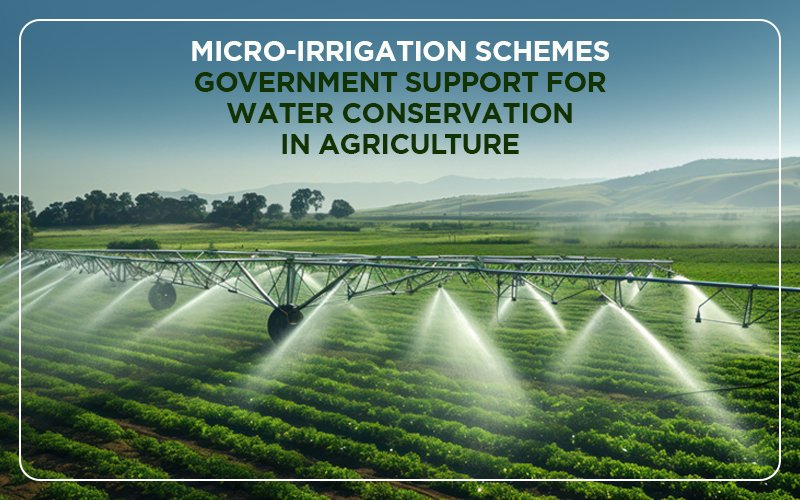
Micro-Irrigation Schemes: Government Support for Water Conservation in Agriculture
Posted on April 22, 2024
Think of a field scorching due to heat; crops are wilting under the sun. These are desperate for every drop of precious water. Now, convert this vision to an identical scene: each plant receives simply the proper quantity of water without delay at its roots. And the roots are directly getting efficient irrigation.
Well, this isn’t a utopian vision, but the fact of micro irrigation schemes. This is a game-changer, revolutionizing India’s agricultural sector.
Water worries plague Indian agriculture
For India, water shortage has been a regular threat since the past. And this shelter directly affects the agricultural zone, the backbone of the nation’s economy. As we can see, growing populations and changing rainfall patterns have impacted the strain on water resources. In such a scenario, traditional flood irrigation strategies only increase the trouble. This is due to the fact that it is wasteful and has uneven distribution across fields. Now here’s where microirrigation schemes step in to offer a specific and green solution.
The Magic of Micro-Irrigation
Think of microirrigation as a custom-designed water delivery machine for crops. This includes techniques like drip irrigation and sprinklers. And these supply small but sufficient quantities of water without delay directly to the plant’s root zone.
Here, drip irrigation uses a network of pipes and emitters that deliver water, like tiny drops, directly to the roots, thus minimizing evaporation. The sprinkler systems, on the other hand, spray water in a controlled way, thus ensuring even distribution across the sector.
A Bounty of Benefits Beyond Water Conservation
The benefits of micro irrigation go a long way beyond water conservation. It is providing a holistic solution for Indian agriculture.
Water Warriors:
Studies show that micro irrigation schemes can store as much as 70% of water compared to conventional methods. In a water-burdened nation like India, this leads to a large win. Thus, it allows for more cultivation with less water.
Happy and healthy crops:
Precise water delivery results in more healthy plants with improved yield and quality. In this way, plants obtain the exact amount of moisture they want. Thus lowering the danger of illness. This leads to better yields, thus encouraging typical agricultural productivity.
Empowering Farmers:
Micro irrigation encourages farmers by giving them extra control over water usage. This then leads to better plans, accelerated productivity, and ultimately, better incomes. Farmers could make knowledgeable decisions about water allocation. These decisions are based on real-time needs and optimize their crop cycles. Thus, the dependence on unpredictable rainfall styles is reduced.
Government Takes Center Stage: Showering Support
Recognizing the capacity of micro irrigation, the Indian government has released numerous projects to promote this practice.
Subsidies and Financial Assistance:
Schemes like the Pradhan Mantri Krishi Sinchayee Yojana (PMKSY) offer subsidies on the set-up of micro irrigation structures. Thus making them more accessible to farmers, especially small and marginal ones. This reduces the initial investment burden on farmers.
Training and Awareness Programs:
The authorities actively promote training programs and workshops. Here, they teach farmers about the benefits and techniques of micro irrigation. This knowledge encourages them to successfully utilize these systems and then eventually maximize their returns. Training also covers proper maintenance practices. Thus, ensuring the long-term functionality and efficiency of the systems.
Focus on the Micro-Irrigation Fund:
A devoted Micro-Irrigation Fund gives extra economic help to states and farmers. Thus promoting good adoption. This guarantees a push toward green water utilization across the country. The fund can also be used to develop and implement innovative solutions. This can address challenges faced by farmers, such as exploring alternative energy sources for operating pumps in remote areas.
Challenges Remain: A Patch of Dry Soil
While the future appears brilliant, there are challenges that need to be addressed. Hence, to make certain the easy implementation and vast adoption of micro irrigation schemes:
Initial Investment:
Although government subsidies help, the initial value of setting up micro irrigation can still be a hurdle for some small and marginal farmers. Addressing this affordability gap remains crucial for wider adoption.
Technical Expertise:
Effective use of micro irrigation requires technical expertise and proper maintenance. This includes training on system troubleshooting, repairs, and the optimal use of technology for maximizing water efficiency.
Power Supply:
In some rural regions, reliable power for working pumps may be a limiting aspect. Exploring alternative energy sources or developing solar-powered solutions could be key to overcoming this challenge.
Looking Ahead: A Sustainable Future
Despite the challenges, micro irrigation schemes are revolutionizing Indian agriculture. With authorities aid, improved focus among farmers is established. There are also progressive solutions to cope with affordability and technical expertise gaps. Those efficient water warriors give priority to a sustainable and rich agricultural future for India. Every drop counts, and micro irrigation ensures each drop reaches where it’s wanted most—at the heart of a healthy and thriving crop, paving the way for an extra water-secure future for the country.
